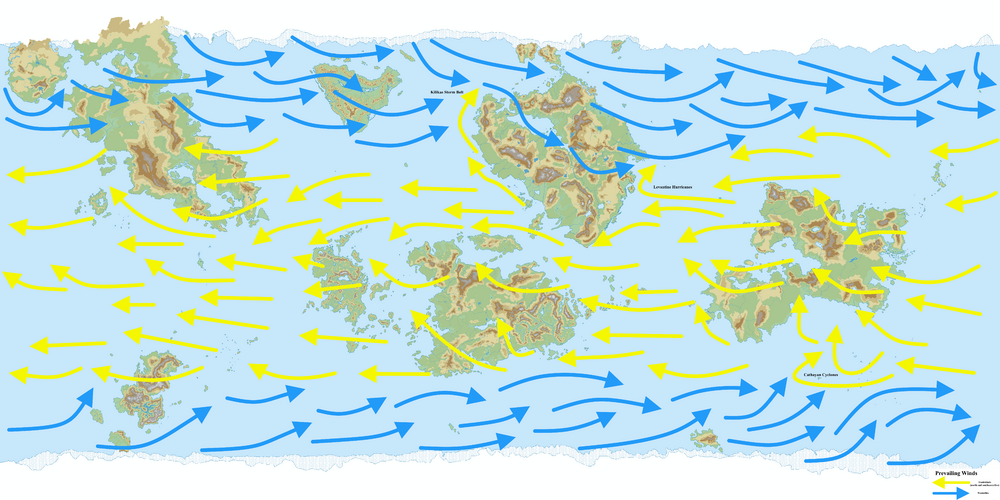Prevailing Winds: Difference between revisions
mNo edit summary |
mNo edit summary |
||
| (One intermediate revision by the same user not shown) | |||
| Line 1: | Line 1: | ||
In meteorology, prevailing wind in a region of the Earth's surface is a surface wind that blows predominantly from a particular direction. The dominant winds are the trends in direction of wind with the highest speed over a particular point on the planet's surface at any given time. A region's prevailing and dominant winds are the result of global patterns of movement in the planet's atmosphere. In general, winds are predominantly easterly at low latitudes globally. In the mid-latitudes, westerly winds are dominant, and their strength is largely determined by the polar cyclone. In areas where winds tend to be light, the sea breeze/land breeze cycle is the most important cause of the prevailing wind; in areas which have variable terrain, mountain and valley breezes dominate the wind pattern. Highly elevated surfaces can induce a thermal low, which then augments the environmental wind flow. | In meteorology, prevailing wind in a region of the Earth's surface is a surface wind that blows predominantly from a particular direction. The dominant winds are the trends in direction of wind with the highest speed over a particular point on the planet's surface at any given time. A region's prevailing and dominant winds are the result of global patterns of movement in the planet's atmosphere. In general, winds are predominantly easterly at low latitudes globally. In the mid-latitudes, westerly winds are dominant, and their strength is largely determined by the polar cyclone. In areas where winds tend to be light, the sea breeze/land breeze cycle is the most important cause of the prevailing wind; in areas which have variable terrain, mountain and valley breezes dominate the wind pattern. Highly elevated surfaces can induce a thermal low, which then augments the environmental wind flow. | ||
Historically, prevailing winds had a major role in human history, allowing for extensive cross-oceanic contact between peoples of [[Audonia]] and [[Sarpedon]]. | |||
Wind roses are tools used to display the direction of the prevailing wind. Knowledge of the prevailing wind allows the development of prevention strategies for wind erosion of agricultural land. Sand dunes can orient themselves perpendicular to the prevailing wind direction in coastal and desert locations. Insects drift along with the prevailing wind, but the flight of birds is less dependent on it. Prevailing winds in mountain locations can lead to significant rainfall gradients, ranging from wet across windward-facing slopes to desert-like conditions along their lee slopes. Prevailing winds can vary due to the uneven heating of the planet. | Wind roses are tools used to display the direction of the prevailing wind. Knowledge of the prevailing wind allows the development of prevention strategies for wind erosion of agricultural land. Sand dunes can orient themselves perpendicular to the prevailing wind direction in coastal and desert locations. Insects drift along with the prevailing wind, but the flight of birds is less dependent on it. Prevailing winds in mountain locations can lead to significant rainfall gradients, ranging from wet across windward-facing slopes to desert-like conditions along their lee slopes. Prevailing winds can vary due to the uneven heating of the planet. | ||
| Line 8: | Line 10: | ||
[[Category: Weather]] | [[Category: Weather]] | ||
[[Category:Nature]] | [[Category:Nature]] | ||
[[Category: IXWB]] | |||
Latest revision as of 08:27, 30 September 2022
In meteorology, prevailing wind in a region of the Earth's surface is a surface wind that blows predominantly from a particular direction. The dominant winds are the trends in direction of wind with the highest speed over a particular point on the planet's surface at any given time. A region's prevailing and dominant winds are the result of global patterns of movement in the planet's atmosphere. In general, winds are predominantly easterly at low latitudes globally. In the mid-latitudes, westerly winds are dominant, and their strength is largely determined by the polar cyclone. In areas where winds tend to be light, the sea breeze/land breeze cycle is the most important cause of the prevailing wind; in areas which have variable terrain, mountain and valley breezes dominate the wind pattern. Highly elevated surfaces can induce a thermal low, which then augments the environmental wind flow.
Historically, prevailing winds had a major role in human history, allowing for extensive cross-oceanic contact between peoples of Audonia and Sarpedon.
Wind roses are tools used to display the direction of the prevailing wind. Knowledge of the prevailing wind allows the development of prevention strategies for wind erosion of agricultural land. Sand dunes can orient themselves perpendicular to the prevailing wind direction in coastal and desert locations. Insects drift along with the prevailing wind, but the flight of birds is less dependent on it. Prevailing winds in mountain locations can lead to significant rainfall gradients, ranging from wet across windward-facing slopes to desert-like conditions along their lee slopes. Prevailing winds can vary due to the uneven heating of the planet.
